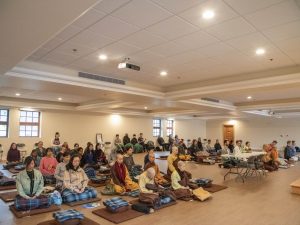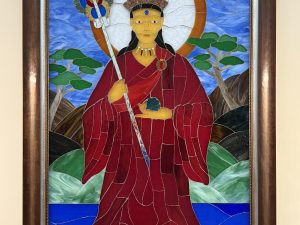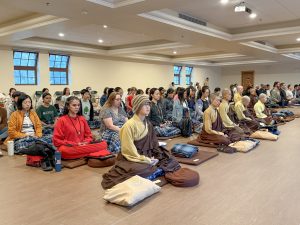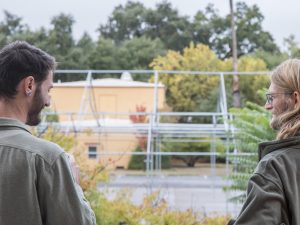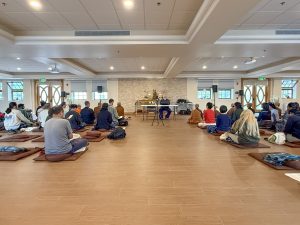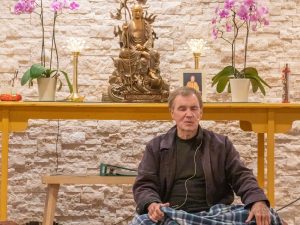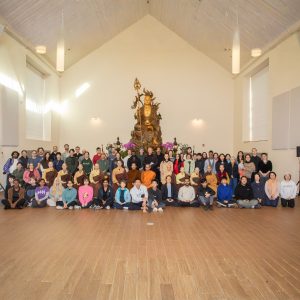
Centered on the theme of the Avataṃsaka Syllabary, this Contemplative Exercise Immersion (CEI) was an invitation to step away from habitual intellectual thinking and attune to our inner wisdom through the sounds of primal syllables and silence.
By chanting, singing, and listening to these syllables, we opened ourselves to a different way of knowing—one that is felt and experienced rather than explained or reasoned out.
Here’s how the experience resonated with some of our students:
MA ‘27 Student Reflections
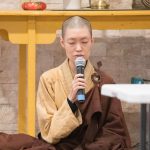
I really liked the theme of this CEI, which involved the Avataṃsaka Dharma door. It reminded me of our university’s name—Dharma Realm Buddhist University—and how the Avataṃsaka Sūtra is described by Venerable Master Hua as a sūtra of the Dharma realm. The Dharma realm is vast and expansive, and I believe the forty-two Avataṃsaka syllables s
erve as a gateway to enter that vastness.
I especially appreciated how a large group of us—faculty, staff, and students from all classes—came together to chant “oṃ ara paca na dhīḥ,” the heart mantra of Mañjuśrī Bodhisattva. The synchronization of everyone’s voices sounded so harmonious, and I could feel the vibration of the sound traveling far and deep. The energy carried a sense of calmness and depth that really touched me.
— Bhikkhunī Jin Nan, MA ’27
 For me, after eight CEIs, I’ve learned to relax into it from the very beginning. No need to resist—just shift into a different mode and follow along, do whatever is said.
For me, after eight CEIs, I’ve learned to relax into it from the very beginning. No need to resist—just shift into a different mode and follow along, do whatever is said.
I remember a moment when I was reading manhwa late one night, and I began to recite just for the fun of it. Suddenly, I had a sharp moment of clarity where a text I had read earlier made sense.
The Laṅkāvatāra Sūtra stated that consciousness ceases but knowledge doesn’t. As I chanted, I realized that the knowledge—
the chanting or the mantra itself—had a sort of permanence or unchanging-ness to it, while my consciousness and state of mind were always changing.
More specifically, I compared my memory of chanting at the CEI earlier in the day and the mental landscape I experienced then with the mental landscape I was experiencing in this moment—late at night, reading manhwa, still chanting.
Same chant, different mind. Stillness, movement.
Perhaps this sort of small insight is my favorite part of CEI. Suddenly, something clicks into sense.
— Sehen, MA ’27
MA ‘26 Student Reflections
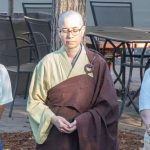 The CEI was a deeply meaningful contemplative experience. I was very grateful to have the opportunity to study with some of our most senior DRBA bhikṣuṇīs who practice the Avataṃsaka Syllabary and have cultivated the Avataṃsaka Sūtra extensively, along with this particular chanting practice for decades.
The CEI was a deeply meaningful contemplative experience. I was very grateful to have the opportunity to study with some of our most senior DRBA bhikṣuṇīs who practice the Avataṃsaka Syllabary and have cultivated the Avataṃsaka Sūtra extensively, along with this particular chanting practice for decades.
We know from the Śūraṅgama Sūtra that Mañjuśrī Bodhisattva recommends cultivating with the ear—Guanyin Bodhisattva’s method—as the best method of cultivation for this current Dharma age.
To be able to recite Mañjuśrī’s mantra while contemplating the sounds and meanings of those syllables, with the entire student body chanting in our recently remodeled Earth Treasury Hall—with its soaring ceilings and resonant space—was a heart- and mind-expanding experience that I will always remember.
— Bhikkhunī Jin Zheng, MA ’26
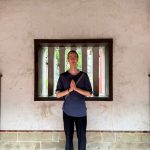 The CEI is always a great time to connect with the DRBU community. This year, we also had the blessing of connecting more closely with the roots of our university. We had the chance to recite the Avataṃsaka Syllabary.
The CEI is always a great time to connect with the DRBU community. This year, we also had the blessing of connecting more closely with the roots of our university. We had the chance to recite the Avataṃsaka Syllabary.
I remember someone telling the story of how Venerable Master Hua was deeply moved the first time it was chanted here. It’s a tradition held very dearly at CTTB, which made a huge difference for this year’s CEI.
The syllabary itself has a very difficult and elaborate melody. But what else could we expect from the Avataṃsaka Sūtra? Its notes go higher than we can sing—just like the Sūtra is unfathomable—and it goes deeper than our voices usually allow, just as the wisdom of the sūtra is infinitely profound.
We had some great cantors leading us in the chanting, just as the monastics lead us in virtue. And although most of us didn’t manage to hit all the notes, we tried our best.
Trying one’s best is, in all reality, the best possible thing one can do—and is thus an expression of our very Buddha nature. Because of that, when we were all singing, we really were in the Avataṃsaka assembly. I believe the youth Sudhana was right there in the Earth Treasury Hall, jumping for joy. These were some very blissful days—it’s rare to have an opportunity like this.
There was also an afternoon session where the whole schedule was sharply disrupted by some impromptu hip-hop music. I was shocked out of my calm; I don’t think I was the only one. But it also made me see how easily the mind attaches to one thing or another. I didn’t like it—and I think that was the point: to try to keep that sense of stillness even amid things that are challenging to see and hear.
Trying to do that, I believe, is an expression of Mañjuśrī’s vows, which one of the Dharma masters lectured on earlier in the week. He vowed to follow living beings into whatever destinies and conditions they find themselves in. So we cannot be attached to one kind of music or form; we need to go out of our comfort zones while keeping a sense of comfort and calm within ourselves.
— Adrian, MA ’26
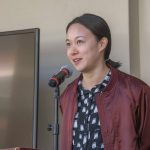 The CEI this year was very special; it was one of the first times since I’ve been here that I’ve seen and been part of the community as a whole— monastics, teachers, students, volunteers coming together and connecting in one breath. Under the shared thread of the Avataṃsaka Syllabary, we were able to share our various practices and approaches to this profound Dharma door and experience the intersection of many worlds in this one brief moment in time. Though I won’t say that I was tapped into the esoteric aspects, I did come out with a deep sense of gratitude and a lightness of heart. Thank you!
The CEI this year was very special; it was one of the first times since I’ve been here that I’ve seen and been part of the community as a whole— monastics, teachers, students, volunteers coming together and connecting in one breath. Under the shared thread of the Avataṃsaka Syllabary, we were able to share our various practices and approaches to this profound Dharma door and experience the intersection of many worlds in this one brief moment in time. Though I won’t say that I was tapped into the esoteric aspects, I did come out with a deep sense of gratitude and a lightness of heart. Thank you!
—Daryle, MA ‘26
The CEI was an interesting event. It has a steep learning curve, especially for those without musical training. I have no idea how to read music, so following along with the group felt like decoding something I had never seen or read before. Luckily, I wasn’t supposed to sing anyway—and that rule saved everyone’s ears, including my own.
Even with my musical confusion, I still enjoyed the event. The sitting meditation and chanting were the highlights. During CEI, I could relax without thinking about homework or deadlines. For once, my mind stopped running in circles about classes.
Insights: Chanting “a ra pa ca na” helped calm my mind. When many people chant together, the sound feels steady and peaceful. By the end of each chanting session, my mind was quiet and clear, making it easy to enter sitting meditation. I actually wished the sitting session had been longer—though my legs might disagree, my mind will be ready for more sitting at the next CEI.
— Venerable Suriya MA ‘26
BA Student Reflections
 CEI has become my favorite, much-awaited, and timely moment within the study semester at DRBU. Submerged by constant waves of precious readings of ancient texts and assignments, CEI week felt like a retreat island where my body and mind could finally pause—to breathe, to lose myself in the moment, and to practice contemplation and insight with the community.
CEI has become my favorite, much-awaited, and timely moment within the study semester at DRBU. Submerged by constant waves of precious readings of ancient texts and assignments, CEI week felt like a retreat island where my body and mind could finally pause—to breathe, to lose myself in the moment, and to practice contemplation and insight with the community.
On the last day, Dharma Master Jin Chuan reminded us to sincerely listen with mindfulness to our own sound. His reminder somehow awakened interest and curiosity in me, and I just did that. What I didn’t know was that at some stage during the walking and chanting, my whole mouth started vibrating so strongly that I had to lift my eyes to double-check whether it was me or my environment creating such a funny thing. It lasted a few seconds and was gone.
This 2025 CEI was amazing—fun and relaxing, yet rich in lectures and the syllabary’s chanting exercises. I remember Dharma Master Liang instructing us to “just chant it,” but most of the time I was trying to follow the guiding tones. When we returned to our original places after circumambulating the Earth Store Hall, we could finally stand still while chanting. I felt relaxed—I could let go and just chant.
— Thanh, BA ’27
 Insights, struggles, surprises: The CEI wasn’t particularly surprising for me since I’m from Thailand and have attended a retreat before. That one was actually more intense and difficult. I remember feeling overwhelmed with anxiety and stress, and often I didn’t want to attend. But I’m glad I did. The walking chanting didn’t seem random to me—it calmed my mind, like a roof sheltering me from a storm, as I focused on the chanting instead of my thoughts.
Insights, struggles, surprises: The CEI wasn’t particularly surprising for me since I’m from Thailand and have attended a retreat before. That one was actually more intense and difficult. I remember feeling overwhelmed with anxiety and stress, and often I didn’t want to attend. But I’m glad I did. The walking chanting didn’t seem random to me—it calmed my mind, like a roof sheltering me from a storm, as I focused on the chanting instead of my thoughts.
A brief snapshot: Worries → calm. During meditation, I wasn’t really able to concentrate—it was hard for me in that mental state. But overall, it was a pleasant experience, especially the walking chanting.
— Nita, BA ’29
Certificate Student Reflections
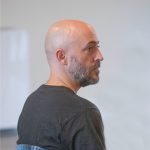 As a mostly silent practitioner, I’m used to long stretches of sitting and walking, but not of reciting. Back home, we might do ten minutes of recitation to thirty of zazen (silent sitting meditation). It was great to push myself outside my comfort zone.
As a mostly silent practitioner, I’m used to long stretches of sitting and walking, but not of reciting. Back home, we might do ten minutes of recitation to thirty of zazen (silent sitting meditation). It was great to push myself outside my comfort zone.
By the end of the third day of singing and reciting, I was tired, and some negative emotions arose. As we walked and chanted after a syllabary session, I wondered, “Why am I not enjoying this as much today? If I find this so beautiful, why do I want it to stop?” And I could hear my mind reply, “I already know what happens next—we’ve done the same so many times already.” It turned out that I was bored. But boredom doesn’t come easily, so I was actually thrilled to experience and observe it. Even that became a learning experience.
The talks were interesting too! I usually use the breath and feeling to reach a place of stillness, but the CEI chanting and talks helped me learn how to access stillness through sound as well—putting it all together. It was a perfect opportunity to practice neither hearing nor not hearing, to meditate on the sound of silence while enjoying the singing crowd.
— Vayu, Translation Certificate Program
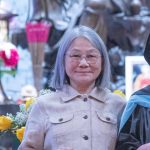 Surprisingly, I felt so safe and protected throughout the CEI. The sound—”a ra pa ca na dhīḥ”—had its notes interwoven into a single, harmonious fabric among us during circumambulation. This resonance continued even afterward, becoming a natural part of the experience.
Surprisingly, I felt so safe and protected throughout the CEI. The sound—”a ra pa ca na dhīḥ”—had its notes interwoven into a single, harmonious fabric among us during circumambulation. This resonance continued even afterward, becoming a natural part of the experience.
Overall, this CEI was truly impressive. The integration of theory, practice, and host sharing was very inclusive, ensuring that no one was left out. I am grateful that the DRBU student body has such dedicated faculty members who continue to shape and refine a unique program for reflection—taking us to the next level, time after time. For me, it was a great week—deceptively demanding and greatly enjoyable.
— Leonie, Culinary Certificate Program
